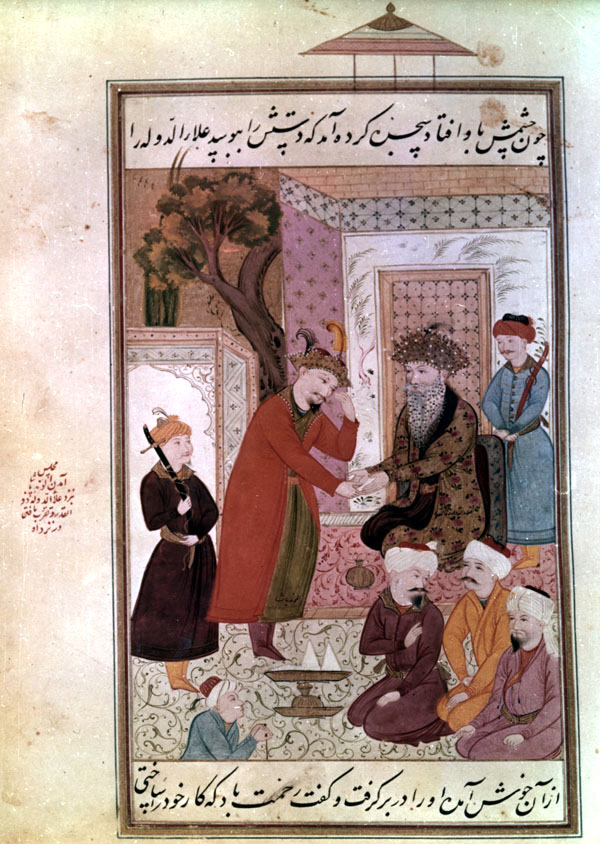Manuscripts
tāriḵ-e ʿālām-ārā-ye šāh esmāʿil
When the Turkman ruler Rostam Šāh died he was survived by four sons. Family intrigues that pitted Āq Qoyunlu against Qarā Qoyunlu resulted in the assaination of the two eldest sons and allowed the third son Alvand Mirzā (also known as Mirzā Alvand Torkmān and Alvand Pāšā) to attain his father’s throne. In the year 907/1500 Esmāʿil was consolidating his position in northwestern Iran, and after having successfully subjugated the province of Širvān (see Manuscript L, folio 62v), and having defeated Sultan Ḥoseyn Bārāni (see Manuscript M, folio 42v), he turned his attention towards the Turkman seat in Tabriz.
Eskandar Monshi states that it was Alvand who first made threatening gestures against Esmāʿil by moving with a large force to Naḵčevān with the intent of taking Širvān, but the text of this manuscript indicates a different chain of events. Here it is stated that when Alvand received word that Esmāʿil was moving in his direction with a large force, he dispatched a letter to Esmāʿil with a peace iniative. Esmāʿil’s response was conditional on Alvand’s embracing Shiʿism and becoming his vassal. This Alvand refused to accept, and a battle ensued which according to Monshi took place near Šarur, near Naḵčevān. Despite the fact that Alvand had reportedly 20,000 troops and the qezelbāš only 7,000, both sources agree on the outcome of the battle, that Alvand was readily defeated, and once the tide of battle had turned against him, Alvand fled in the direction of Diār Bakr. Esmāʿil pursued the fleeing Alvand for some distance, but unable to catch up with him, returned and entered Tabriz in triumph, where he was coronated shah and proclaimed Shiʿism as the state religion (see Manuscript L, folio 74 and M, folio 48v).

Alvand was cordially received in Diār Bakr by ʿAlā al-Dowla Ẕuʾl-Qadar, who owed a debt to the Turkman rulers of Tabriz. This initial meeting of the two personages is the scene depicted here on folio 51. After the cordialities had been dispensed with, Alvand requested, and received, a force of 20,000 fresh troops from ʿAlā al-Dowla Ẕuʾl-Qadar with which to again confront Esmāʿil.
Upon arriving in the vicinity of Tabriz, Alvand learned that Esmāʿil and the main Safavid force had departed Tabriz leaving only a contingent under the command of Halvāči Oḡli. Alvand entered Tabriz from another route than that used by Esmāʿil, and once inside took vengeance on the residents who had converted to Shiʿism. He reportedly slew 7,000 residents. Meanwhile, Halvāči Oḡli mustered his limited forces and was defending the city as best he could from the roof tops. The Shiʿite residents joined forces with him, but those that were Sunni refrained from fighting.
At this point Esmāʿil had a dream where he foresaw wild dogs attacking Tabriz, and without delay returned with the main force to Tabriz. For a second time, Esmāʿil resoundingly defeated Mirzā Alvand, who again fled when the tide of battle had turned against him. This time, however, he did not bother to stop at Diār Bakr, but continued on to Turkey. Monshi reports that Alvand died in Diār Bakr in 910/1504.
ʿAlā al-Dowla Ẕuʾl-Qadar, ruler of Marʿaš, Albestān, and Diār Bakr, is represented with a bejeweled white beard, jewel studded crown, and brocaded coat, seated on a carpet before a tiled pavilion, with his arms outstretched to greet the visitor. Alvand, dressed in an olive garment with vermillion topcoat
and jewelled headgear, stands before the Ẕuʾl-Qadar and gestures a salam. Both Alvand and al-Dowla are accompanied by retainers holding their swords in ceremonial position, and are shown in true hieratic scale slightly smaller and a few steps behind their respective masters. Three observers are seated in the lower right foreground, and a fourth almost caricatured man with a cane or walking stick, is shown in profile in the lower left, cropped at the waist by the frame. The color scheme consists primarily of a light mauve and a light gray (or white), with touches of vermillion, olive, light blue, light orange, and dark purple.
Painting: 23.2 x 13.0 cm. One line of text above and below the painting. Frame encloses painting and text; cupola above the tiled pavilion protrudes beyond the frame into the upper margin. No signs of damage or retouching. A marginal inscription in red, presumably of later date, describes the event depicted. Inscriptions, one in red and the other in black, are written on two of the figures, identifying them as Alvand Pāšā and ʿAlā al-Dowla Ẕuʾl-Qadar.
Painting references:
Mahboubian_1972, #923 folio 51 (not illustrated).
Text X-references:
See Muntaẓer-Ṣāḥeb_1970, p.63 for this event in the History of Shah Esmāʿil.
See Savory, SA_1979, pp.44-45 for this event in the History of Shah ʿĀbbās.
Robert Eng
Last Updated: December 2, 2010
Originally published: March 28, 2002